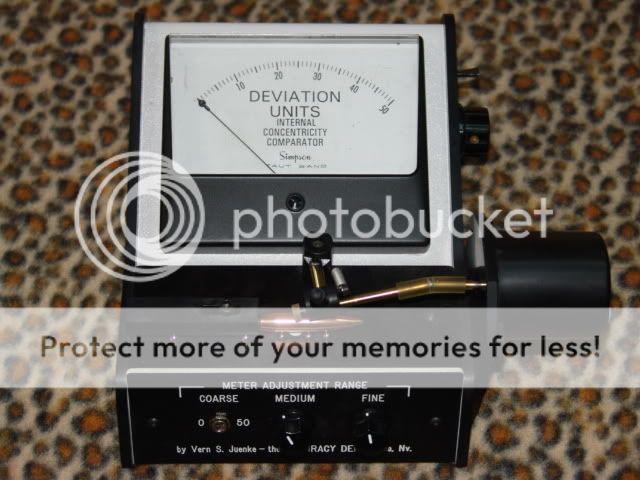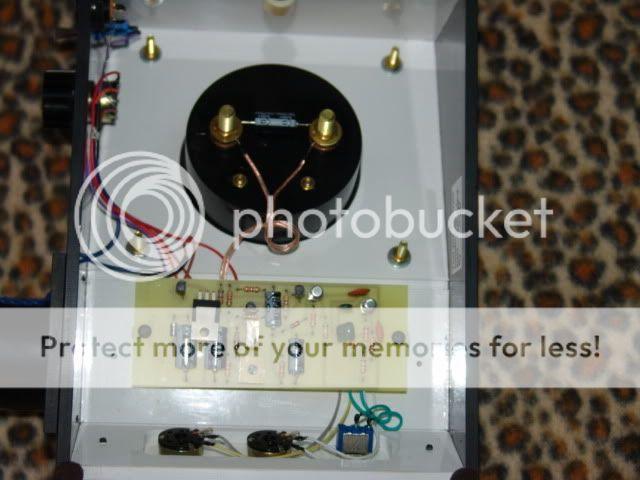Seeing this thread led me to wondering about how the juenke machine works. I bought one abut 10 years ago and experimented with it some. About all I learned from it at the time was that the better quality bullets I was using gave lower reading than cheaper bullets. I ran a few hundred Berger and Sierra jacketed match bullets and some Lost River turned solids on it. There was some small variation in angular postion with just about all bullets I tried, but i never saw any with variations that I though I could use for sorting.
In the Juenke liturature there was mention of "ultrasonic" and I though the tests were acoustic using ultrasoinc vibration to sense deviation between bullets. This thread got me thinking about how the Juenke test set really works, so I drug out some test equipment and made measurements. Basically the Juenke is similar to a metal detector used to locate coins. It has CW oscillator running at close to 200 kilohertz connected to a 3 lead inductor sitting just below the bullet. The waveform is sinusoidal and unmodulated. I didn't measure the power of the oscillator, but it's probably around a hundred milliwatts A bullet or any metallic object set above the coil will change the coupling and thus the output amplitude from the coil. the switch and two potentiometers on the front panel just balance the meter to show a small portion of the total range of possible output. None of the knobs adjust sensitivity, only offset.
The device (bullet, case, or whatever) being tested rests on four fixed hard ball bearings which , along with a position stop form a kinematic mount. four points on the surface of cylinder will accurately locate the centerline of a cylinder without clamping. A motor with an elastic roller is lowered onto the upper surface of the object to turn it abuot the cylinder's axis. This allows checking if the object has radial symmetry, at least as seen by the inductor. The motor is adjustable up to about 1 revolution per second. It is not any kind of static or dynamic balance test. There are two additional steel balls. I assume their function is to make it easier to remove bullets being tested
or perhaps if you want to check the symmetry of the ogive or boattail relative to the shank.
What can the Juenke really sense? First its sensitive to the diameter of the cylinder. A smaller cylinder will lay closer to the detector. That will show up as a change in the meter when the cylinder is placed on the machine. It's sensitive to the conductivity of the object. Bullets from different manufacturers may have slightly different conductivity even for identical dimenstions based on the alloy. Coatings such as moly have no effect that I can detect. The reading is affected by the thickness of the material. At 200 khz the skin effect is incomplete. To test this I placed large area brass shim about as thick as a cartridge wall over the sensor, then lowered a second smaller shim over than but not allowing them to touch. The meter moved a couple of divisions before the two pieces made contact indicating that it was sensing the second shim though the first. However a lead block (much less conductive) was barely detectable. Those tests don't require rotating the device being tested.
When a cylinder (case or bullet) is rotated, the set is sensitive to any surface irregularities, to most shapes of surface distortion, and no doubt to variation in the wall or jacket thickness even if it's internal to the portion of the cylinder which is above the inductor. I do not believe it is capable of detecting voids in the core of a jacketed bullet, at least not in the presence of the typical 1 to 3 points of meter movement seen in most bullets.
I did run enough tests to convince myself that the Juenke is not making acoustic ultrasonic tests. The only thing "ultrasonic" about it that some people call any signal between about 20 khz and 1mhz as ultrasonic whether electrical or acoustic. The Juenke does not appear to have significant capacitive coupling as adding a dielecric under the test object does not change the reading. I was not able to make measurements on ceramic or plastic cylinders.
The circuitry is all analog using discrete components. The only IC is a voltage regulator. The unit has little drift, at least not enough to be annoying. Testing an object takes 5 to ten seconds to load, watch the meter for one revolution, remove the test sample and sort or record something The unit has no electrical output to connect to a computer, but I don't think it would be difficult to add.
In general I do not believe the Juenke does a definitive good/bad tests on bullets or cases. Having good readings on the Juenke does not prove a bullet with shoot well. I do think that testing sample batches of bullets can show ones which have more internal or external variations. I do not believe it will show up bullets which may have internal voids or unbalances in the lead core. Sorting batches of bullets and rejecting those with large variations in the reading when rotated or with high or low average readings may weed out some potential "fllyers" but I doubt though it is capable of detecting all defects in bullets. I believe that acoustic ultrasonic tests could do better, but the equipment would likely be even more expensive.
For those who haven't seen a Juenke, here's one inside and out. This one is about ten years old and a bit worn but working ok.



